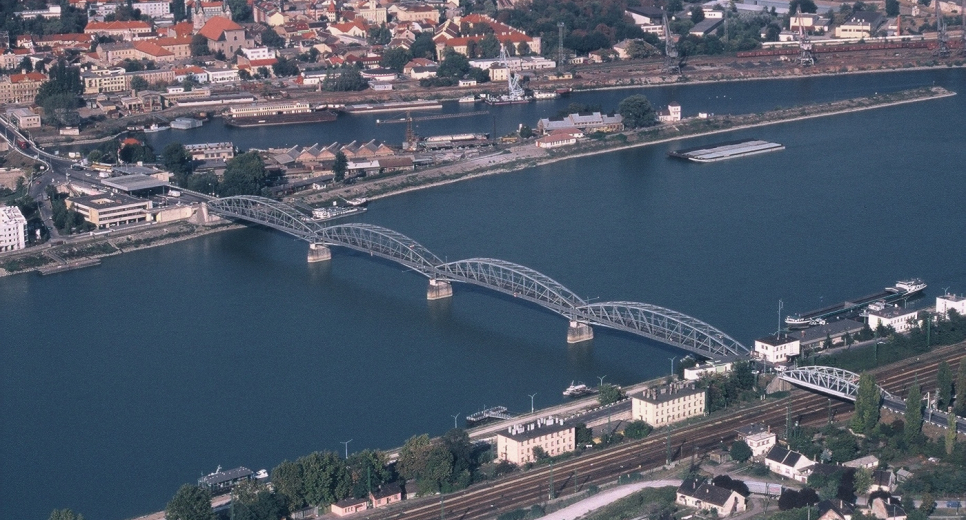
Komárom / Komárno and their environs

KOMÁROM
Komárom is a small town in the Central Transdanubian Region, in the northern part of the Komárom-Esztergom county, in the Komárom district named after the city, in a beautiful natural environment, which lies on the banks of the Danube. It gained its current form after the Trianon decision that ended World War I, as the northern part of Komarno became a part of Czechoslovakia a long time ago.
The cultural, touristic and commercial center with about 20,000 inhabitants has favorable economic geography. The M1 highway passes near the settlement, the main road 1 crosses the town, and the railway line to Győr and Vienna continues here. The good transport connections, the proximity of the Danube and the border made it an attractive location for many multinational companies. In recent years, several huge investments have created hundreds of new jobs, and further significant investments are still underway.
The main attraction of Komárom is the fortress system that surrounds the city, which is on the list of proposed UNESCO World Heritage Sites. The fortress system consists of 5 parts, two in the area of historical Komárom in Slovakia, and three in the area of present-day Komárom in Hungary.
The thermal spa located in the city center and the waterside leisure park built on the edge of the city offer opportunities for relaxing relaxation. Szőny, Ószőny, today a district of Komárom. In the Roman era, the famous Roman city of Brigetio was located here.
Important sights of Komárom and its surroundings:
- Brigetio Spa
- Monastery fortress
- Star Fort
- Igmándi Fortress
- Puskaporosi WF Leisure Park
- Hungarian Equestrian Theatre
- Solymosy–Gyürky Castle
Komárno (Szlovákia)
Komárno is a town in Slovakia, in the Komáromi district of Nitra district, at the confluence of the Danube and the Vág-Danube. It is also called Észak-Komárom, Oreg-Komárom, and some people call it Slovak-Komárom, to distinguish it from the former southern part of the city, which is now an independent settlement in Hungary called Komárom (or South-Komárom). Komárom is the seat of the district and the third most populous city in the Nyitra district after Nyitra and Érsekújvár. It is the most important cultural and political center of Hungarians in Slovakia. The city is an important machine industry (shipbuilding) center as well as a busy Danube cargo port. It is connected to Komárom in Hungary by road by the Erzsébet Bridge, and by rail by the Komárom Railway Bridge. It used to be a road and rail border crossing, but after the accession of Slovakia and Hungary to the Schengen agreement, this role ceased.
The city of Komárno was founded after the conquest, in the 11th century, although the right bank of the Danube was already inhabited by the Romans. During the time of the Kingdom of Hungary, it was the seat of the county of Komárom, and it received city status on April 1, 1265. The city functioned as a final fortress during the Turkish subjugation, the construction of the Komárom fortress system began after the unsuccessful Turkish siege in 1594. The fortresses also played an important role in the 1848-49 War of Independence, during which three battles took place between the troops of the Habsburg Empire and Hungary. After the First World War, the border of the newly founded Czechoslovakia was drawn in the middle of the Danube, thus separating the northern and southern parts of the city. Due to the Trianon border, it lost almost half of its 3,000 km² catchment area, which significantly set it back in development. The development of the city accelerated only during the decades of socialism, through industrialization.
Komárno has also been a university town since 2004, where the János Selye University was founded as the first Hungarian-language university in Slovakia. Its main attraction is the fortress system surrounding the city, which is on the UNESCO World Heritage list.
Monuments:
The Museum along the Danube
Downtown:
Komárom Castle (Old and New Castle)
Klapka square
- Statue of General György Klapka
- City Hall
- Zichy Palace – European Court, II. Statue of King András, Országalma fountain, Music Pavilion
- England Park
- Officer Pavilion
Nádor street
- Ghyczy mansion
- Saint Andrew's Church
- Benedictine monastery
- Museum along the Danube
- St. Joseph's Chapel
- Cheerful
- Grand Café
- grid church
County street
- Holy Trinity statue
- Central Hotel (now an insurance company)
- County Hall
Jókai street
- St. Anne's Chapel
- Memorial plaque of Mór Jókai and János Selye
- Reformed church and Reformed college
Kossuth Square
- Saint Rosalia church
Street of Franciscan friends
- Military Church
- evangelical church
Port district:
- Small Jewish Church, Holocaust memorial plaque
- Bratislava Gate
Komárom cemeteries
Single:
- Komárom fortress line VI. bastion - Roman stone repository (lapidarium)
- Bastion V - T-gallery
- Apáli gate